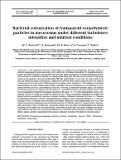Por favor, use este identificador para citar o enlazar a este item:
http://hdl.handle.net/10261/20270COMPARTIR / EXPORTAR:
 SHARE SHARE
 CORE
BASE CORE
BASE
|
|
| Visualizar otros formatos: MARC | Dublin Core | RDF | ORE | MODS | METS | DIDL | DATACITE | |

| Título: | Bacterial colonization of transparent exopolymeric particles in mesocosms under different turbulence intensities and nutrient conditions |
Autor: | Pedrotti, M.L.; Beauvais, S.; Kerros, M.-E.; Iversen, K.; Peters, Francesc CSIC ORCID | Palabras clave: | Transparent exopolymer particles Particle colonization Bacteria FISH Turbulence Nutrients Mesocosms |
Fecha de publicación: | 24-jun-2009 | Editor: | Inter Research | Citación: | Aquatic Microbial Ecology 55(3): 301-312(2009) | Resumen: | We examined bacterial colonization of transparent exopolymeric particles (TEP) in nutrient-manipulated mesocosms subjected to different turbulence intensities. We quantified heterotrophic bacterial abundance, production and diversity using fluorescence in situ hybridization (FISH). The abundance of attached bacteria increased significantly with TEP size in all treatments. The slope values of the number of bacteria scaled with TEP size varied from 1.15 on Day 1 to 2.04 on Day 11 in still and turbulent tanks, respectively. Comparison between these slopes indicated that the number of attached bacteria for a given TEP diameter was higher under turbulence. The addition of nutrients and turbulence in mesocosms neither supported higher bacterial abundance nor resulted in a correlation between bacterial concentrations and TEP. However, in enriched turbulent tanks, the number of attached bacteria was higher and was linked to rapid TEP formation after the diatom bloom. This was accompanied by higher bacterial production (1.21 µmol C l–1 d–1 at the intermediate level of turbulence on Day 9), which was positively related to TEP. These correlations highlight the finding that higher bacterial productivity was due to a larger fraction of attached bacteria (up to 56.4%). Changes in bacterial production occurred with simultaneous changes in the community structure, i.e. the percentages of the Cytophaga-Flavobacteria-Bacteroides cluster increased significantly. By Day 9, this cluster became the dominant group of bacteria attached to TEP (85 and 90%, respectively at intermediate and high levels of turbulence). Among the marine heterotrophic bacterioplankton, this phylum is known to be common as attached bacteria. Therefore, it seems that the added nutrients and subsequent TEP production can be used by bacteria more efficiently under turbulent conditions through a shift in group-specific composition towards more attached bacteria with higher production rat | Descripción: | 12 pages, 7 figures, 2 tables | Versión del editor: | https://doi.org/10.3354/ame01308 | URI: | 10261/20270 | DOI: | 10.3354/ame01308 | ISSN: | 0948-3055 | E-ISSN: | 1616-1564 |
| Aparece en las colecciones: | (ICM) Artículos |
Ficheros en este ítem:
| Fichero | Descripción | Tamaño | Formato | |
|---|---|---|---|---|
| Pedrotti_et_al_2009.pdf | 586,23 kB | Adobe PDF |  Visualizar/Abrir |
CORE Recommender
SCOPUSTM
Citations
18
checked on 20-abr-2024
WEB OF SCIENCETM
Citations
17
checked on 28-feb-2024
Page view(s)
362
checked on 24-abr-2024
Download(s)
85
checked on 24-abr-2024
Google ScholarTM
Check
Altmetric
Altmetric
NOTA: Los ítems de Digital.CSIC están protegidos por copyright, con todos los derechos reservados, a menos que se indique lo contrario.
